Australia‘s “cultural cringe”
One of the challenges of being a “migrant” in Australia is understanding the “cultural cringe” that infects so much of Australian life. I’ve lived and worked here for 45 years and it still puzzles me. For those not familiar with it, it is an internalised inferiority complex that causes us to dismiss our own culture as inferior to the cultures of other countries. It makes us vulnerable to cultural imperialism.
As a planner, I am constantly bewildered by Australians’ need to turn to other countries for planning models – for density, urban design and community engagement. We have many brilliant theorists and practitioners, yet we invite outsiders with sometimes mediocre credentials to brief our planning managers and train our staff. The results are rarely successful.
It’s easy for those outsiders to assume that Australia is “just like” Canada, the USA or the UK.
How wrong they are!
The Density Wars
As the “density wars” heat up in all Australian capital cities, turning to outsiders for planning advice becomes even more problematic. And, sadly, the one place Australian governments and developers turn is the one place we should avoid – at least for now. That’s my hometown of Vancouver.
As state governments in Australia try to find ways to sell increased housing densities to a reluctant public and recalcitrant local councils, one model has slipped into the conversation that should, in my view, quietly slip away. That’s the recent Vancouver invention of EcoDensity. This failed housing density initiative with a dodgy pedigree is being touted by visiting Vancouverism boosters as one of the answers to our housing density needs. Nothing could be further from the truth, as a significant amount of recent scholarly and practical research reveals.
Origins of Vancouver’s EcoDensity Policy
I was in Vancouver in June, 2006, when the then Mayor, Sam Sullivan, sought to impress World Urban Forum delegates with his new initiative: EcoDensity. The name was made up by his Chief of Staff. Sam took advice from people who did not know about or fully understand the complex and sophisticated legacy of CityPlan and neighbourhood planning. He passed the idea by several academics and developers unfamiliar with the CityPlan Neighbourhood Centre rezoning program. There was no other scrutiny, especially by knowledgeable planners and managers within Council. By the time the Vancouver City planners got the job of explaining and implementing it, EcoDensity was a “done deal”.
Sullivan even tried to patent the term.
Speed was of the essence: the aim was “Doing it faster”, unlike Toronto, which built only 200 laneway infill units (several years before EcoDensity was coined by Sullivan) before they abandoned their discretionary zoning policy.
A massive City public relations program from 2006-2007 trumpeted this new initiative, which was seen by the spin-doctors as more interesting with “eco” than boring old “planning” or scary new “density”. The 2008 Council meeting to endorse it lasted for six nights, with 151 speakers lined up.
The EcoDensity Charter
It took two years and four official drafts to approve the EcoDensity Charter. It is now widely accepted that the Charter misrepresented community views and did not adequately address issues raised in the public process. There were strong community complaints of misrepresentation by Council officers (and senior planners) of the contents of community submissions; there were serious weaknesses in the analysis of submissions about the draft Charter. In meetings to work out the Charter, it was observed that the moderator skewed public comments.
In the community’s view, the 2008 EcoDensity Charter represented a “battering ram” approach to densification. Considerable discretionary power was eventually granted to Council by the Charter, thus undermining well-established policies of community engagement and implementation. Despite the extensive publicity campaign, the community hated and distrusted the policy. It sank Sam Sullivan politically. Shortly after he announced it, his popularity went into steep decline and, despite thirteen years as a City Councillor, he lost candidature after only one term as Mayor. Anti-EcoDensity public sentiment was a significant factor in his 2008 election loss. The new City Planner, Brent Toderian, inherited the policy in 2006; he had to run with it. Not surprisingly, it took its toll on him, as well.
Justifications for EcoDensity
You’d have to pity the City’s planners who were forced to implement this policy, this new “sustainability fix”. Their mandate was one of neutralizing opposition, while promoting social welfare through affordability. (And you’d also wonder why they did not speak up.) Instead, they went along with it, claiming that Laneway Housing was essentially “invisible” and easily absorbed. Laneway Housing before this time was about the only thing the new planning regime implemented on their watch (and it failed to deliver a significant increase in density). It was parallelled in terms of community opposition and distrust by the now infamous failed “Thin Streets” initiative (which had also been mooted in Council years before but failed to get endorsement).
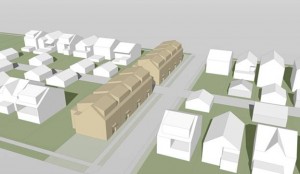
With regard to Laneway Housing, the city’s planners argued, unconvincingly, that gentle, hidden and invisible forms of density were possible in suitable locations across the City with design that respected neighbourhood identity. It was promoted as having the same envelope as a permitted garage, but two storeys were allowed. In fact, 95% of Laneway Housing permits issued were for two storeys, thus negatively affecting privacy and shadowing back yards, which conflicted with urban agriculture policies and reduced songbird habitat.
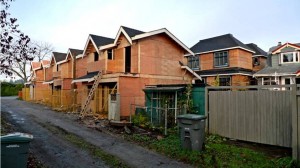
My sister, living in Marpole, now wonders if her beautiful garden, that is her delight and solace, will be in full shadow throughout the day in all seasons with proposed height increases on Oak Street.
Will she have to move?
These were the sorts of concerns that Vancouver residents expressed in 2007 and onwards. Knowledgeable critics acknowledged some eco-footprint benefits in EcoDensity as, in terms of development and environmental stewardship, it showed some promise. However, community people soon pointed out that regulations made laneway houses unnecessarily costly to build. In violation of basic sustainability principles, EcoDensity in laneways — as currently implemented in Vancouver –encourages demolition and replacement of existing dwellings, with loss of embodied energy and character. Those two weaknesses alone neutralized its power as the “new sustainability fix”. The Council ignored suggestions from community members about how Laneway Housing could be less costly and intrusive but they were ignored.
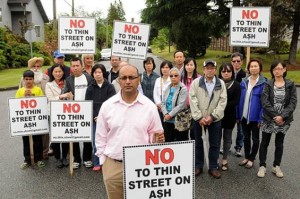
Research reveals that even the City of Vancouver planners were not convinced that the policy would work. Brent Toderian was quoted in 2007 as saying: “EcoDensity won’t provide housing that meets average incomes. I don’t think we would affect housing supply to the point that prices would go down.”
A 2007 staff report agreed that the “trickle-down” effect would not work for housing affordability. If they were referring to so-called “filtering” (i.e., the concept in housing research that older residences, once sold by their owners so they can downsize, move into a retirement community, etc., become available as affordable housing to younger buyers), they were right that it simply doesn’t function in Vancouver’s housing market. Nevertheless, in November 2013, Toderian told a Sydney audience that, “EcoDensity gave a good context for an idea that didn’t have traction.”
Community and professional views
Research revealed that, in Vancouver, local people were not scared about density until June 2006, when the Mayor “put the fear of density into people.” EcoDensity was seen as an “institutional fix” to make densification acceptable: a “Trojan horse”. To many local people in 2006, density was seen as equal to development and profit to developers. Densification consistent with “Community Choices” had been approved under CityPlan Visions and under pre-existing Local Area Plans (but that density was primarily small-scale, not suited to major developers and overseas condominium pre-sales). #/nom-generique-du-cialis/ There was a pre-existing public understanding of density after years of sensitive community engagement conducted by the City. Those sensitive approaches and the densities they involved conflicted with the kinds of density envisaged by Eco-Density supporters.
The Sullivan initiative heralded a new era of top-down city policy making and implementation. People were frightened – and angry. One community view was that EcoDensity opened floodgates for more large-scale types of development, which were not consistent with existing plans or “discretionary” urban design guidelines. Researchers found that EcoDensity destroyed public confidence in “discretionary zoning”.
There is a great irony in this destruction of confidence. An approach which had been designed to placate opposition to housing density (to “clothe the wolf of densification in the sheep’s clothing of eco-trendy jargon”) had failed miserably. One of the two former City Planners (either Larry Beasley or Ann McAfee) was quoted in academic research as saying, “By putting the dirty word of density with the very sweet and tasty word of eco – you launder the dirty word of density.” Not surprisingly, others cottoned on as well. Community people challenged the discursive connection between density and affordability. It was seen as a prominent example of how environmental concerns can be co-opted to neutralize environmental opposition by promoting a value-free vision with “win-win-wins” among economic growth, social development and ecological protection. What was seen as manipulative rhetoric designed to break down resistance and opposition led to perceptions of false promises and misleading descriptions (in the engagement processes).
Some people argued that EcoDensity deceptively sells densification for profit – using the values of liveability, sustainability and affordability. Basically, they argued, it serves developers, not communities. Many experienced critics (including current and former City staff) felt that they were tangled up in political sloganeering and deliberate attempts to mislead, deceive and lull people into acquiescence. City planners were forced to promise one thing and enable another. Basically, for the communities, it boiled down to a simple suspicion: the whole policy was nothing more than a publicity campaign for the Mayor aimed at serving developers’ interests.
As a result, decades of careful policy development and trust building (guided by the stellar former co-director of planning, Dr Ann McAfee) became mired in distrust. Now Vancouver’s neighbourhoods were experiencing for the first time in decades a lack of genuine participation and the over-riding of community planning.
What people feared
What people feared was not density but overcrowding. Community concerns focused on problems associated with very dense neighbourhoods and what was coined “green overcrowding” (density without amenity). The policy was seen as greenwashing of developers’ agenda. Critics were concerned that EcoDensity would sacrifice liveability and that led to anxiety and open protests in a number of neighbourhoods. Before long, Vancouver’s neighbourhoods were in uproar. At risk were Ann McAfee’s carefully crafted visioning processes for neighbourhood plans under CityPlan. Now local people felt that EcoDensity would destroy their communities.
Neighbourhoods for a Sustainable Vancouver (NSV)
EcoDensity had a strong effect on organising and uniting neighbourhoods and the modern wave of Vancouver community action (described recently by eminent Vancouver journalist, Frances Bula as “a peasant revolt”) we see today around Community Plans and rezoning was reborn at this time. In 2007, Neighbourhoods for a Sustainable Vancouver (NSV) was established. It was the first time in the City’s history that neighbourhood groups from across the City had come together to protest. There were concerns about weak leadership in planning and a flawed engagement processes that allowed visions and local area plans to be overridden. More than anything, people were concerned (as they are today in Vancouver) that EcoDensity centralized implementation away from the community.
Effects on existing CityPlan processes
Until the arrival of EcoDensity, density discussions in Vancouver were proceeding amicably. One of the big differences between EcoDensity and earlier densification programs (like False Creek North, Yaletown and Downtown) is that the latter occurred in brownfields sites rather than in existing lower-density single-family neighborhoods. The earlier effects were not felt in low-density residential neighbourhoods. The City Plan Vision framework, approved in 1995, envisaged “A City of Neighbourhoods” and “community involvement in decision-making”. The community visioning process took CityPlan to the neighbourhood level, with communities developing detailed
local vision directions. With EcoDensity, these initiatives were ignored. The new language of EcoDensity was seen as undermining both CityPlan community visions and residents associations. Not surprisingly, community members questioned: Was this policy a continuation of CityPlan (city visioning processes) – or a disruption? Proponents of EcoDensity, including senior planners, marketed it as a continuation; opponents clearly experienced it as a disruption.
The tragic legacy of EcoDensity is a governance one. It undermined the effectiveness of CityPlan, whose artful design and implementation had had the effect of de-politicising the planning process. Now the Vancouver planning process is fully politicised. Decades of work by the previous two highly skilled City Planners was eroded. And the firestorm that we see in Vancouver today is the direct result.
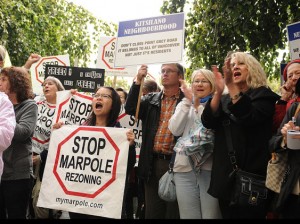
The current situation in Vancouver regarding EcoDensity
Widespread opposition to EcoDensity-spawned top-down Council planning continues to grow. Neighbourhoods for a Sustainable Vancouver (NSV) is running a candidate for the 2014 mayoral race, as well as candidates for the Council, School Board and Parks Board.
In 2013, the “Coalition of Vancouver Neighbourhoods” (CVN) was formed to establish a “new planning paradigm. The CVN is currently questioning the City’s inflated population projections, demanding that community planning processes return to the CityPlan practice of public workshops and surveys to consider and select among various options for housing density − not single options seen by community members as created in back rooms by the developer-influenced City administration.
It’s a great tradition that is set to continue: it is widely accepted that Vancouver’s liveability was founded on opposition to planning experts. EcoDensity has been continued only half-heartedly by the new Council, which now boasts the “Greenest City Initiative”. The current Council is also beholden to real estate development interests because of huge election campaign contributions (with no controls in British Columbia). They avoid the term EcoDensity because of its wide unpopularity and partisan rivalry. However, EcoDensity continues to be cited in staff reports and some EcoDensity policies continue to be implemented by the current Council.
In summary: Why EcoDensity is a failure?
- It arose from a top-down public relations initiative and never had widespread popular or Council support.
- The way it was initiated led to initial mistrust and the ways it was implemented continue to contribute to mistrust.
- It promised much more than it delivered.
- It did not make housing more affordable.
- It did a poor job of improving social equity.
- It did not provide enough new housing units to satiate the demand.
- It contributed to a breakdown of trust between communities and the Council.
- It re-politicised the planning process and destroyed social capital and relationships established through the extensive CityPlan processes.
What can we learn from this – in Australia?
This is a cautionary tale that we ignore at our peril – as communities, planners and governments. First, let’s learn from our own experiences, do the relevant research – here and abroad – mine the archives, refresh the institutional memories and learn to think for ourselves.
Second, let’s respect our overseas colleagues and engage with them – but as equals, not as supplicants. The City of Vancouver has made many mistakes, as have our larger cities. But it’s only a small place with 600,00 residents. We have larger cities and bigger problems – and many smart people to address them.
Third, let’s fearlessly face “the cringe” and vow to create our own planning solutions. We can learn from others. Yes. And we can come to our own decisions.
And finally, let’s beware of the spin-doctors. One recently told an Australian audience packed full of activists and planners that planners and governments need to “be more creative now about how you `brand’ ideas.”
The spin-doctors have all but ruined planning in Vancouver. Let’s not learn from them how to do that better.
Because if we want learn how to do spin doctoring better, Vancouver is definitely the place to go.
Selected sources:
Brown, Ryan C. (2008). Reconciling Ecological and Social Sustainability: The Case of the EcoDensity Initiative. Research Report, Vancouver Island University, 30 May 2008, https://newcity.ca/Pages/ecodensity.pdf, accessed 19 December 2013.
Bula, Frances (2012). “Vancouver city planner sees term ended by Vision council,” State of Vancouver, 31 January: https://www.francesbula.com/uncategorized/vancouver-city-planner-sees-term-ended-by-vision-council/, accessed 19 December 2013.
Condon, Patrick (2013). Blog: “Whose City is it Anyway?”, The Tyee, https://thetyee.ca/Opinion/2013/08/26/Whose-City-Is-It/ 26 August, accessed 19 December 2013.
Eggleton, Crystal and Peter McMahon (2013). “What is EcoDensity?“ Clayton Utz Insights, 23 May, https://www.claytonutz.com/publications/edition/23_may_2013/20130523/what_is_ecodensity.page, accessed 19 December 2013.
Pacheco-Vega, Paul (2009). “Laneway housing, affordability and EcoDensity: Preliminary thoughts,” 4 August, https://www.raulpacheco.org/2009/08/laneway-housing-affordability-and-ecodensity-preliminary-thoughts/, accessed 19 December 2013.
Rosol, Marit (2013). “Vancouver’s “EcoDensity” Planning Initiative: A Struggle over Hegemony?” Urban Studies 50 (11), August: 2238-2255.
Sarkissian, Wendy (2013). “EcoDensity,” The NIMBY Clearinghouse, https://thenimbyclearinghouse.wordpress.com/tag/eco-density/, accessed 19 December 2013.
Sham, Fred (2012). The urban political ecologies of Vancouver: Sustainable development and affordability. Unpublished Master of Science in Planning thesis, Columbia University, May. https://academiccommons.columbia.edu/catalog/ac%3A147370, accessed 19 December 2013.
Sullivan, Sam (2013). “How Vancouver’s EcoDensity Ideas can Help Sydney”, 20 April 2013. https://www.samsullivan.ca/vancouvers-ecodensity-ideas-sydney/, accessed 19 December 2013.
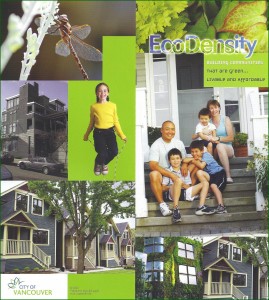
The problem with Australian decision makers are that they show physcopathic tendencies. They also copy other trends instead of designing the ones that is needed in Australia.
Lack of Remorse or Guilt A lack of feelings or concern for the losses, pain, and suffering of victims; a tendency to be unconcerned, dispassionate, coldhearted, and unempathic. This item is usually demonstrated by a disdain for one’s victims.
Beware Australia, the situation here in Vancouver is exactly as Wendy has described it. You can only use the word “planning” in quotes when discussing what comes out of city hall here. Don’t listen to anyone coming from Vancouver with advice, they’re either hacks or flacks. Or both.
It’s all greenwashing subterfuge by oleaginous city pols on behalf of their developer pals, spun by the fart-catchers of both. What results is ugly, cheap-looking density completely out of proportion to its surroundings and degrading to the quality of life wherever it lands, rammed past local opposition, one neighbourhood at a time.
And it’s all enabled by the provincial govt allowing a scandalous system with NO restrictions on civic campaign funding (unlike the limitationsthe provincial and federal levels both have.)
Wendy’s comments on Ecodensity are both refreshing and bang on correct. Beware Australia, Vancouver is blowing up as a result of ecodensity policies. Almost nobody is happy except the developers who are laughing all the way to the bank.